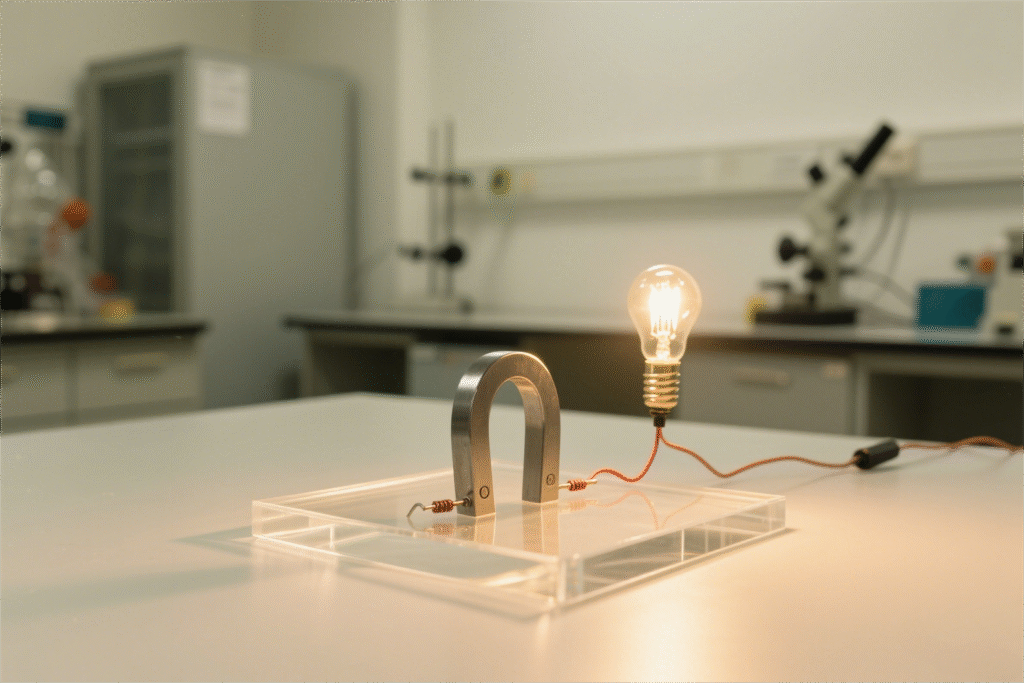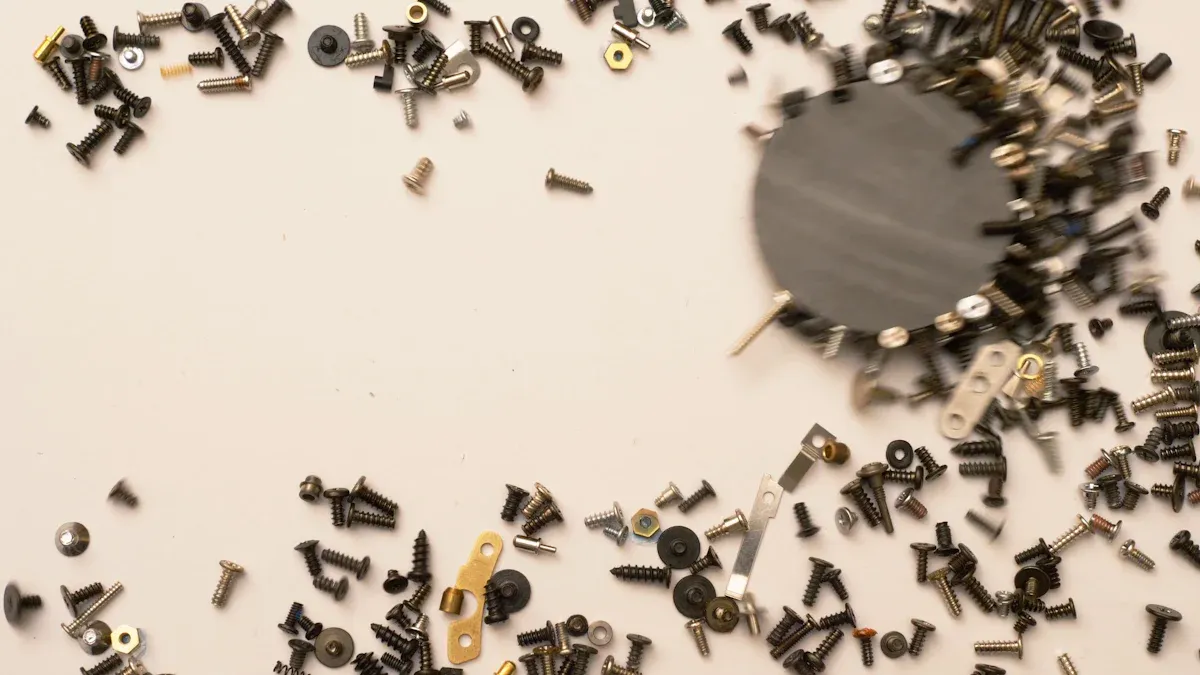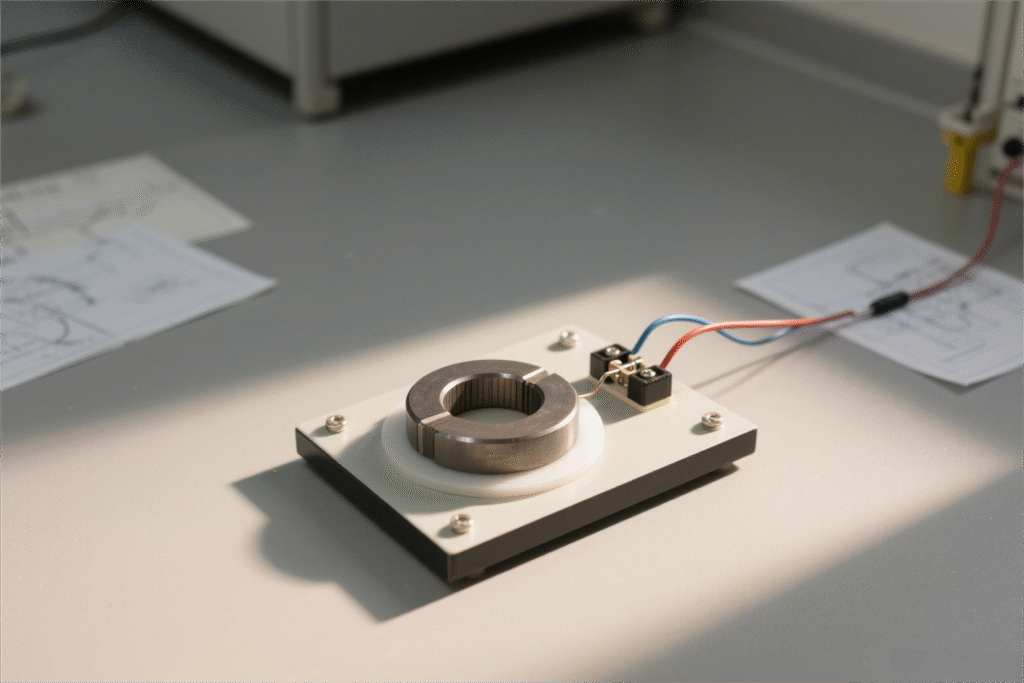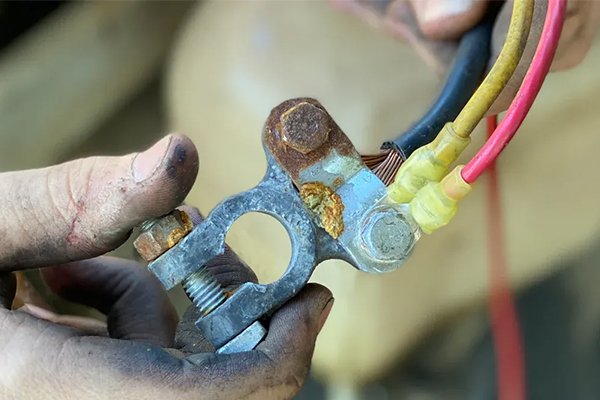No, not every magnetic material lets electricity flow. Electrical conductivity depends on how atoms are set up in magnetic materials. It also depends on how easily electrons can move. Scientists use special tools like neutron and x-ray scattering to study magnetic materials. These tools help them see how atoms are lined up inside these materials. The results show that even tiny changes in the structure of magnetic materials matter. These changes can affect how electrons move. This is important for technology and daily life. Devices need magnetic materials with the right properties to work well.
Key Takeaways
- Not every magnetic material lets electricity flow. Their atoms decide if electrons can move easily. Some magnetic materials, like iron and nickel, let electricity pass well. These are used in motors and transformers. Other magnetic materials, like ferrites, do not let electricity pass. They block electricity but still have magnetism. Ferrites help stop energy from being wasted. Engineers pick magnetic materials for what a device needs. Some devices need both magnetism and electricity. Others only need magnetism. Knowing how magnetism and electricity work together helps make better devices. This helps things like speakers, hard drives, and medical machines work better.
Magnetic Materials and Conductivity
Magnetism Basics
Magnetism happens because electrons move and spin inside atoms. Some materials have groups of atoms called magnetic domains. Each domain works like a small magnet. The direction of these domains can change. This change affects how magnetic the material is. Scientists use special tools to look at these domains. Magneto-optic Kerr effect (MOKE) microscopy shows big domains by seeing changes in light. Lorentz microscopy helps scientists see tiny domains in thin films.
- Magnetic domains lower the total magnetic energy in a material.
- Domain walls are borders where magnetization direction changes.
- Grain size changes how domains form. Small grains can make one domain. Big grains split into many domains.
- Coercivity and remanence are important measurements. They show how hard it is to change magnetization and how much magnetism stays after removing a magnetic field.
Scientists sort magnetic materials by how they react to magnetic fields:
- Ferromagnetic materials have strong domains that line up easily. Iron and nickel are examples.
- Paramagnetic materials have weak and short-lasting magnetism.
- Diamagnetic materials push away magnetic fields and do not have domains.
Conductivity Basics
Electrical conductivity tells us how well electrons move in a material. Metals usually let electrons move easily, so they conduct well. Insulators stop electrons from moving. The way atoms are arranged and bonded controls how easily electrons travel.
Researchers study how electrons move to learn about conductivity. In SrSnO3 perovskite oxides, scientists measured how electrons bounce off crystal vibrations. These vibrations are called phonon modes. Phonon modes can slow down electrons. In graphene, electrons move very fast, especially when it is cold. Graphene can have mobility up to 200,000 cm²/V·s at room temperature. This means electrons face little resistance. In other materials, like antimony selenide, mobility changes with temperature and crystal structure. These facts help engineers pick the right material for electronics.

Relationship Between Magnetism and Conductivity
Not every magnetic material conducts electricity well. The atomic structure controls both properties, but they do not always go together. Iron is both magnetic and conducts electricity well. Ferrites are magnetic but do not conduct electricity. Ferrites have bonds that block electrons from moving, even though they are magnetic.
Studies show that changing the number of free electrons can change both magnetism and conductivity. In (Zn,Co)O thin films, more free charge carriers changed the magnetic behavior and how the material reacted to magnetic fields. At low temperatures, the material had high resistance and strong positive magnetoresistance. When it became more conductive, the magnetoresistance turned negative. This means the same material can act differently if more electrons are free to move.
Here is a table showing how atomic structure affects both properties:
| Magnetic Material Type | Electrical Conductivity (S/m) | Explanation |
|---|---|---|
| Ferromagnetic Materials (Iron) | ~1.0 × 10⁶ | Metallic nature with many free electrons enabling both magnetism and good conductivity. |
| Neodymium Magnets | 1.4 × 10⁶ | Contains iron contributing to moderate electrical conduction alongside strong magnetism. |
| Alnico Magnets | ~1.5 × 10⁶ | Alloy of aluminum, nickel, cobalt with moderate conductivity and strong magnetic properties. |
| Ferrites | 10⁻⁶ to 10⁻⁹ | Ceramic compounds with low conductivity due to covalent/ionic bonding despite magnetic behavior. |
| Soft Magnetic Materials (Silicon Steel) | ~1.1 × 10⁶ | Developed for electrical use, balancing good conductivity with magnetic softness. |
| Magnetite (Iron Oxide) | ~10⁻² | Natural mineral with low conductivity due to restricted electron mobility, yet magnetic. |
| Cobalt-based Magnets | ~1.7 × 10⁶ | Significant magnetic strength and moderate conductivity due to cobalt content. |
Some magnetic materials, like ferrites, have a structure that keeps electrons from moving. Others, like iron or neodymium magnets, have metallic bonds that let electrons flow. The way atoms are arranged and bonded decides if a material is both magnetic and conductive. In special nanocomposites, scientists can change the atomic structure. This lets them control both magnetism and conductivity at the same time.
Note: Not all magnetic materials are metals. Some, like ferrites, are ceramics and act as insulators. This is important when making devices that need both magnetic and electrical properties.
Types of Magnetic Materials

Conductive Types
Some magnetic materials let electricity pass through them easily. These materials usually have a metallic structure. Their atoms are set up so electrons can move around. This movement causes both magnetism and electrical conductivity.
- Iron is a well-known example. It is very magnetic and conducts electricity well. The crystal structure of iron helps electrons move. That is why it is used in transformers and electric motors.
- Nickel is also in this group. It is ferromagnetic but does not conduct as well as iron. Nickel does not rust easily, so it is used in tough places.
- Neodymium magnets (NdFeB) are made from neodymium, iron, and boron. These magnets are very strong and conduct electricity because they are metallic.
- Alnico magnets have aluminum, nickel, and cobalt. They are strongly magnetic and conduct electricity at a medium level.
- Lanthanum strontium manganite (LSMO) is a special oxide. It is both magnetic and conducts electricity well because of double exchange.
| Material | Electrical Conductivity (% IACS) | Magnetic Properties | Corrosion Resistance | Typical Applications |
|---|---|---|---|---|
| Iron | ~18% | Strong ferromagnetic | Moderate | Transformers, electric motors, electromagnetic devices |
| Nickel | ~1-2% | Ferromagnetic (lower permeability) | Superior | Aerospace, marine, industrial uses |
Scientists learned that how these materials are made changes their properties. For example, smaller crystals in iron oxide make more defects. These defects can change how well electricity moves through the material. Temperature and the direction of a magnetic field also change resistance. In iron and nickel, resistance goes up when the magnetic field is in the same direction as the current. It goes down when the field is sideways. This is called anisotropic magnetoresistance.
Insulating Types
Some magnetic materials do not let electricity flow. These materials are called insulators. Their atoms are arranged so electrons cannot move, but they still show magnetism.
- Ferrites are ceramics made from iron oxide and other metals. They are very magnetic but do not conduct electricity well. Ferrites are used in transformer cores and antennas to stop energy loss.
- Samarium-cobalt (SmCo) magnets are strong and stable. They do not rust and can handle heat. SmCo magnets do not conduct as well as metal magnets because of their crystal structure.
- Yttrium iron garnet (Y₃Fe₅O₁₂) is a complex oxide. It is magnetic but does not let electricity flow. Scientists use it in microwave and optical devices.
Most nonmetallic magnetic materials do not conduct electricity. Their structure keeps electrons from moving, so electric current cannot flow. This helps stop unwanted heating in electronics.
Scientists saw that the size and shape of these materials change their resistance. In spinel materials like SnFe₂O₄, resistance changes with temperature and magnetic field. Smaller pieces and more defects can make resistance higher. Granular magnetic systems show special effects at low temperatures, like tunneling resistance and Coulomb blocking, which make it even harder for electricity to flow.
Magnetic materials come in many types. Some conduct electricity well, but others do not. People pick the right one for each job.
Comparison Table

Conductive vs. Insulating
Magnetic materials can be conductors or insulators. Their properties depend on how atoms are set up. Electrons move easily in some, but not in others. The table below shows the main differences. It lists examples, conductivity or resistivity, and where they are used.
| Material Type | Examples (Composition) | Conductivity/Resistivity (μΩ·cm) | Typical Uses |
|---|---|---|---|
| Conductive | |||
| Silicon Steel | 3% Si, balance Fe | 47 – 50 | Transformers, electrical utility industry |
| Low Carbon Steel | 99.5% Fe | 12 | Small motors, generators |
| Permalloy | 79% Ni, balance Fe, 4% Mo | 58 | High-performance magnetic applications |
| Amorphous Magnets | Fe-based alloys with B, Si, C | 125 | Low core loss magnetic cores |
| Insulating | |||
| Ferrite | Fe₂O₃ with Mn, Zn, or Ni | 10⁶ – 10⁸ (very high) | Transformer cores, antennas, EMI suppression |
| Yttrium Iron Garnet | Y₃Fe₅O₁₂ | >10⁸ (extremely high) | Microwave devices, optical isolators |
| Samarium-Cobalt Magnet | SmCo | ~10⁶ (high) | High-temperature magnets, aerospace |
Note: Conductive magnetic materials, like silicon steel and permalloy, let electrons move easily. This helps in devices that need both magnetism and electricity, like transformers and motors. Insulating magnetic materials, such as ferrites and yttrium iron garnet, stop electricity from flowing. Engineers use these to prevent energy loss in transformer cores or microwave devices.
People pick different magnetic materials for each device. Conductive types are best when both magnetism and electricity are needed. Insulating types help stop extra heating and energy loss. This comparison helps engineers and students see why certain materials are chosen for special uses.

Applications
Electrical Devices
Engineers pick magnetic materials with care for devices. How well a material conducts electricity can change device performance. Transformers use soft magnetic materials like silicon steel or ferrite in their cores. These materials help energy move by letting magnetic fields pass through. They also control how much electric current flows. Transformer cores have thin metal sheets called laminations. Laminations lower energy loss from eddy currents. Eddy currents are loops of electricity that make heat. Using insulating materials like ferrites stops these currents. This keeps devices cooler.
Motors need magnetic materials too. Permanent magnets and electromagnets work together in motors. They change electrical energy into movement. Custom motor stators in generators use special magnetic materials. This makes motors work better and last longer. Flexible electronics use composites with magnetic fillers and conductive polymers. These materials can sense magnetic fields and make heat. They can also bend without breaking. In medicine, scientists use superparamagnetic nanoparticles. These tiny particles help control how well blood conducts electricity. This shows how magnetism and conductivity work together in new technology.
| Device Type | Magnetic Material Used | Purpose |
|---|---|---|
| Transformer | Silicon steel, ferrite | Efficient energy transfer, reduced heat |
| Motor (Stator) | Iron, rare-earth magnets | Convert electricity to motion, improve efficiency |
| Flexible Sensor | Magnetic composites | Sense fields, generate heat, stay flexible |
Everyday Uses
People use magnetic materials every day. Refrigerator magnets hold up notes and pictures. Speakers use magnets to turn electricity into sound. Hard drives save data by changing tiny magnetic domains. Credit cards have magnetic stripes to store information. Induction cooktops heat pots with magnetic fields. Compasses point north using magnets. MRI machines use strong magnets to take pictures inside the body. Electric motors run fans, toys, and home appliances. Magnetic levitation trains float above tracks for smooth rides. These examples show how magnets help make life easier and safer.
Not every magnetic material lets electricity pass through. The way atoms are arranged and how many free electrons there are decide if electricity can flow. Iron and nickel are both magnetic and let electricity move. Ferrite is magnetic but does not let electricity flow. The table below shows how they are different:
| Material | Magnetic | Conductive |
|---|---|---|
| Iron | Yes | Yes |
| Nickel | Yes | Yes |
| Ferrite | Yes | No |
Engineers have to pick the best material for each use. Knowing these differences helps make devices safer and work better.
FAQ
What makes a material magnetic?
Magnetic materials have atoms with electrons spinning the same way. This makes tiny magnetic fields. When lots of atoms line up, the whole material acts magnetic.
Tip: Iron, nickel, and cobalt are very magnetic. Their atoms line up easily.
Can all magnets conduct electricity?
Not every magnet lets electricity move through it. Iron is a magnet that conducts electricity. Ferrite is a magnet that blocks electric current. The way atoms are arranged decides if a magnet conducts electricity.
Why do engineers use insulating magnetic materials?
Engineers pick insulating magnetic materials to stop unwanted currents. These materials help keep devices cooler and save energy. They are used in things like transformers and antennas.
Are all metals magnetic?
Most metals are not magnetic. Only a few, like iron, nickel, and cobalt, are strongly magnetic. Metals such as copper and aluminum do not stick to magnets.
How do magnetic materials help in daily life?
Magnetic materials are useful in many ways. They help store computer data and run motors in machines. They hold notes on fridges, guide compasses, and make speakers work.

